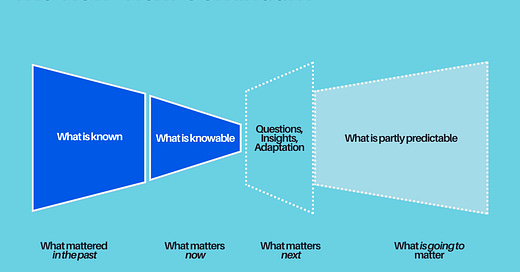The Art of Asking "What's Next" (Without a Crystal Ball)
Why the right questions matter more than the right predictions
"What's next?"
It's the question that launches a thousand think pieces every December, spawns endless trend reports, and keeps strategic planners up at night. But most of the time, we're asking it wrong.
Here's what I mean: when most people ask "what's next," they're really asking "what should I predict?" As if the future were a multiple-choice test where getting the right answer earns you a strategic advantage.
But prediction isn't the point. Preparation is.
As I often say, you don't need to predict the future to prepare for it. The real power lies in asking questions that help us act meaningfully today, regardless of exactly how tomorrow unfolds.
The Problem with Prediction-Based Thinking
Every December, the business world gets flooded with "next year trends" content. By January, most of it's forgotten. By March, half of it's proven wrong. Why? Because we're trying to predict specific outcomes instead of building capacity for multiple possibilities.
This is why I just published my Strategic Foresights for 2025 in June, not December. And why I'm not calling them "trends" at all.
Trends imply things that are already happening — patterns you observe and react to. Strategic foresights are different. They're frameworks for understanding forces that help you shape the future rather than be shaped by it.
The Now-Next Continuum: How Change Actually Works
The future doesn't arrive all at once. It unfolds along what I call the Now-Next Continuum — a series of interconnected moments where today's decisions create tomorrow's possibilities.

Think about it: the organizations thriving in 2025 aren't those who predicted every specific development. They're the ones who built adaptive capacity, asked better questions, and remained focused on human outcomes while everything else shifted around them.
This is Strategic Optimism in action — neither dystopian nor utopian, but actively engaged in creating better futures.
Questions That Lead to Insights (Not Just Speculation)
The magic happens when we shift from prediction questions to preparation questions:
Instead of: "Will AI take our jobs?"
Ask: "How might AI reshape the nature of human work, and what distinctly human capabilities should we cultivate now?"
Instead of: "What's the next big tech trend?"
Ask: "What human needs persist regardless of technological change, and how can we better serve them?"
Instead of: "Should we centralize or decentralize?"
Ask: "What functions benefit from centralization versus decentralization, and how do we optimize for human flourishing in each?"
This is how we move from questions to insights to foresights — creating actionable intelligence rather than just collecting predictions.
The Five Questions That Actually Matter
Based on my analysis of forces reshaping business in 2025, here are the strategic questions worth asking:
How do we build adaptive capacity for uncertainty rather than trying to eliminate it? (Strategic uncertainty as competitive advantage)
Where should human agency be preserved versus where can AI provide genuine enhancement? (Human-AI symbiosis challenge)
What would our business model look like if sustainability were built into the architecture rather than bolted on top? (Beyond ESG theater)
Which decisions benefit from centralized expertise and which improve when pushed closer to human impact? (Strategic organizational design)
How do we build governance that enhances rather than constrains our ability to innovate responsibly? (Proactive human-centered governance)
Why This Approach Actually Works
When you ask better questions about the future, you develop what I call "scenario fluency" — the ability to thrive across multiple possible outcomes rather than betting everything on one prediction.
This isn't about being prepared for everything (impossible) or nothing (useless). It's about building organizational muscles that get stronger regardless of which specific challenges emerge.
The organizations succeeding in 2025 share this pattern: They start with human outcomes they want to create, then work backward to determine what capabilities and decisions serve those outcomes across different scenarios.
Your Next Step
Choose one area of your work or organization and try this reframe:
What are you currently trying to predict about its future?
What would you ask instead if the goal were building adaptive capacity rather than getting predictions right?
How might this shift change what you do today?
The future is coming whether we're ready or not. But it's not coming TO us — it's being created BY us, through the questions we ask and the decisions we make today.
Better questions lead to better insights. Better insights lead to strategic foresights. And strategic foresights help us participate in creating futures worth building.
Read the full Strategic Foresights analysis →
What questions are you asking about the future of your work or industry? I'd love to hear your thoughts in the comments below.
About Kate O'Neill
Kate O'Neill is the "Tech Humanist" — a strategic thinker who shapes how organizations understand and implement human-centered technology. Her analysis influences Fortune 100 leaders, municipal executives, and healthcare innovators navigating technological transformation while maintaining focus on human dignity and meaningful outcomes.
As author of "What Matters Next: A Leader's Guide to Making Human-Friendly Tech Decisions in a World That's Moving Too Fast" and host of The Tech Humanist Show, Kate translates complex technological and strategic concepts into frameworks that help leaders build future-ready organizations. Her strategic foresights and implementation insights reach decision-makers across industries who are rethinking how technology should serve human potential.
Kate speaks internationally on strategic technology implementation, publishes influential analysis on emerging technological forces, and works with leaders who recognize that the most sustainable competitive advantages come from aligning technological capability with human flourishing — what she calls "Strategic Optimism" for shaping better futures.
Connect: KO Insights | LinkedIn | The Tech Humanist Show




